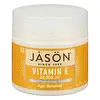What's inside
What's inside
 Key Ingredients
Key Ingredients

 Benefits
Benefits

 Concerns
Concerns

 Ingredients Side-by-side
Ingredients Side-by-side

Water
Skin ConditioningTocopheryl Acetate
AntioxidantGlycerin
HumectantCetyl Alcohol
EmollientStearic Acid
CleansingCaprylic/Capric Triglyceride
MaskingDimethicone
EmollientGlyceryl Stearate Se
EmulsifyingHelianthus Annuus Seed Oil
EmollientPersea Gratissima Oil
Skin ConditioningCitrus Grandis Fruit Extract
AstringentAscorbic Acid
AntioxidantCarbomer
Emulsion StabilisingPotassium Cetyl Phosphate
EmulsifyingPotassium Hydroxide
BufferingSorbic Acid
PreservativeBenzyl Alcohol
PerfumingPhenoxyethanol
PreservativePotassium Sorbate
PreservativeSodium Benzoate
MaskingWater, Tocopheryl Acetate, Glycerin, Cetyl Alcohol, Stearic Acid, Caprylic/Capric Triglyceride, Dimethicone, Glyceryl Stearate Se, Helianthus Annuus Seed Oil, Persea Gratissima Oil, Citrus Grandis Fruit Extract, Ascorbic Acid, Carbomer, Potassium Cetyl Phosphate, Potassium Hydroxide, Sorbic Acid, Benzyl Alcohol, Phenoxyethanol, Potassium Sorbate, Sodium Benzoate
Water
Skin ConditioningGlycerin
HumectantCoco-Caprylate
EmollientXanthan Gum
EmulsifyingCapryloyl Glycerin/Sebacic Acid Copolymer
Skin ConditioningDiheptyl Succinate
EmollientCamellia Sinensis Leaf Extract
AntimicrobialTocopheryl Acetate
AntioxidantRetinol
Skin ConditioningBakuchiol
AntimicrobialPanthenol
Skin ConditioningGlyceryl Stearate
EmollientGlyceryl Stearate Citrate
EmollientPotassium Cetyl Phosphate
EmulsifyingGlycolic Acid
BufferingSodium Hydroxide
BufferingLavandula Angustifolia Oil
MaskingHelianthus Annuus Seed Oil
EmollientPersea Gratissima Oil
Skin ConditioningSesamum Indicum Seed Oil
EmollientPolysorbate 20
EmulsifyingSalvia Officinalis Oil
MaskingBeta-Caryophyllene
MaskingEucalyptol
PerfumingCitrus Aurantium Dulcis Peel Oil
MaskingL-Alpha-Pinene
PerfumingCamphor
MaskingCitral
PerfumingGeranyl Acetate
PerfumingMentha Viridis Leaf Oil
AstringentCitronellal
MaskingPhenoxyethanol
PreservativeEthylhexylglycerin
Skin ConditioningWater, Glycerin, Coco-Caprylate, Xanthan Gum, Capryloyl Glycerin/Sebacic Acid Copolymer, Diheptyl Succinate, Camellia Sinensis Leaf Extract, Tocopheryl Acetate, Retinol, Bakuchiol, Panthenol, Glyceryl Stearate, Glyceryl Stearate Citrate, Potassium Cetyl Phosphate, Glycolic Acid, Sodium Hydroxide, Lavandula Angustifolia Oil, Helianthus Annuus Seed Oil, Persea Gratissima Oil, Sesamum Indicum Seed Oil, Polysorbate 20, Salvia Officinalis Oil, Beta-Caryophyllene, Eucalyptol, Citrus Aurantium Dulcis Peel Oil, L-Alpha-Pinene, Camphor, Citral, Geranyl Acetate, Mentha Viridis Leaf Oil, Citronellal, Phenoxyethanol, Ethylhexylglycerin
Ingredients Explained
These ingredients are found in both products.
Ingredients higher up in an ingredient list are typically present in a larger amount.
Glycerin is already naturally found in your skin. It helps moisturize and protect your skin.
A study from 2016 found glycerin to be more effective as a humectant than AHAs and hyaluronic acid.
As a humectant, it helps the skin stay hydrated by pulling moisture to your skin. The low molecular weight of glycerin allows it to pull moisture into the deeper layers of your skin.
Hydrated skin improves your skin barrier; Your skin barrier helps protect against irritants and bacteria.
Glycerin has also been found to have antimicrobial and antiviral properties. Due to these properties, glycerin is often used in wound and burn treatments.
In cosmetics, glycerin is usually derived from plants such as soybean or palm. However, it can also be sourced from animals, such as tallow or animal fat.
This ingredient is organic, colorless, odorless, and non-toxic.
Glycerin is the name for this ingredient in American English. British English uses Glycerol/Glycerine.
Learn more about GlycerinHelianthus Annuus Seed Oil is the oil derived from the seeds of a Sunflower. Sunflower seed oil is non-fragrant. It is an emollient, meaning it helps to soften the skin.
Sunflower seed oil contains many fatty acids. The fatty acids found in sunflower seeds include (from highest amount to least): linoleic acid, myristic acid, palmitic acid, stearic acid, arachidic acid, oleic acid, and linolenic acid.
These fatty acids help the skin create ceramides. Ceramides play a role in repairing the skin barrier.
Helianthus Annuus Seed Oil helps moisturize the skin. This in turn helps the skin look more rejuvenated and smoother.
Sunflowers are rich in vitamin E.
Historians believe Indigenous cultures of North America domesticated sunflowers before corn. Thus they relied on sunflower oil for a variety of uses. One such use is moisturizing skin and hair.
Sunflower seed oil may not be fungal acne safe. We recommend speaking with a professional if you have any concerns.
Learn more about Helianthus Annuus Seed OilPersea Gratissima Oil is also known as avocado oil.
Avocado Oil has antioxidant properties. It is mostly made up of the glycerides of fatty acids. About 67% of these fatty acids is made up of oleic acid. Palmitic acid and linoleic acid are also present.
These fatty acids help hydrate and soften the skin. It may increase collagen content in the skin. Collagen helps keep your skin plump and firm. This ingredient helps reduce inflammation and has not shown to clog pores.
This ingredient may not be fungal-acne safe due to its high fatty acid content.
Avocados also have B vitamins, vitamin K, vitamin C, vitamin E, and potassium.
Learn more about Persea Gratissima OilPhenoxyethanol is a preservative that has germicide, antimicrobial, and aromatic properties. Studies show that phenoxyethanol can prevent microbial growth. By itself, it has a scent that is similar to that of a rose.
It's often used in formulations along with Caprylyl Glycol to preserve the shelf life of products.
Potassium Cetyl Phosphate is the potassium salt of a mixture. This mixture consists of the esters from phosphoricacid and cetyl alcohol.
Potassium Cetyl Phosphate is an emulsifier and cleansing agent. Emulsifiers help stabilize a product. It does this by preventing certain ingredients from separating.
As a cleansing agent, Potassium Cetyl Phosphate helps gather oils, dirts, and pollutants from your skin. This makes it easier to rinse them away with water.
Learn more about Potassium Cetyl PhosphateTocopheryl Acetate is AKA Vitamin E. It is an antioxidant and protects your skin from free radicals. Free radicals damage the skin by breaking down collagen.
One study found using Tocopheryl Acetate with Vitamin C decreased the number of sunburned cells.
Tocopheryl Acetate is commonly found in both skincare and dietary supplements.
Learn more about Tocopheryl AcetateWater. It's the most common cosmetic ingredient of all. You'll usually see it at the top of ingredient lists, meaning that it makes up the largest part of the product.
So why is it so popular? Water most often acts as a solvent - this means that it helps dissolve other ingredients into the formulation.
You'll also recognize water as that liquid we all need to stay alive. If you see this, drink a glass of water. Stay hydrated!
Learn more about Water